Antibody data
- Antibody Data
- Antigen structure
- References [1]
- Comments [0]
- Validations
- Western blot [1]
- Immunocytochemistry [3]
- Immunohistochemistry [2]
- Other assay [4]
Submit
Validation data
Reference
Comment
Report error
- Product number
- PA5-114830 - Provider product page

- Provider
- Invitrogen Antibodies
- Product name
- Apelin receptor Polyclonal Antibody
- Antibody type
- Polyclonal
- Antigen
- Synthetic peptide
- Description
- Antibody detects endogenous levels of total AGTRL1.
- Reactivity
- Human, Mouse, Rat
- Host
- Rabbit
- Isotype
- IgG
- Vial size
- 100 μL
- Concentration
- 1 mg/mL
- Storage
- -20°C
Submitted references Apelin‑13 alleviates diabetic nephropathy by enhancing nitric oxide production and suppressing kidney tissue fibrosis.
Gao Z, Zhong X, Tan YX, Liu D
International journal of molecular medicine 2021 Sep;48(3)
International journal of molecular medicine 2021 Sep;48(3)
No comments: Submit comment
Supportive validation
- Submitted by
- Invitrogen Antibodies (provider)
- Main image
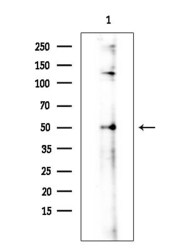
- Experimental details
- Western blot analysis of Apelin receptor extracts from EC304 cells (heat-shock treatment). Samples were incubated with Apelin receptor polyclonal antibody (Product # PA5-114830) using a dilution of 1:1,000. Observed bands: 50 kDa.
Supportive validation
- Submitted by
- Invitrogen Antibodies (provider)
- Main image

- Experimental details
- Immunocytochemistry analysis of Apelin receptor in 293 cells. Samples were treated with PFA, permeabilized in 0.1% Triton X-100, blocked in 10% serum (45 min at 25°C), and incubated with polyclonal antibody (Product # PA5-114830) at a dilution of 1:200 (1 hr at 37°C). Secondary staining was applied with Alexa Fluor 594 conjugated goat anti-rabbit IgG using a dilution of 1:600.
- Submitted by
- Invitrogen Antibodies (provider)
- Main image
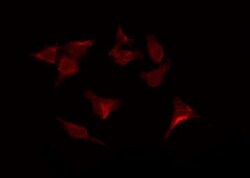
- Experimental details
- Immunocytochemistry analysis of Apelin receptor in 293 cells. Samples were treated with PFA, permeabilized in 0.1% Triton X-100, blocked in 10% serum (45 min at 25°C), and incubated with polyclonal antibody (Product # PA5-114830) at a dilution of 1:200 (1 hr at 37°C). Secondary staining was applied with Alexa Fluor 594 conjugated goat anti-rabbit IgG using a dilution of 1:600.
- Submitted by
- Invitrogen Antibodies (provider)
- Main image
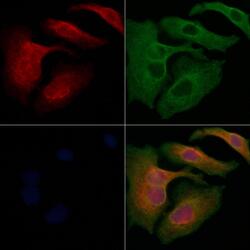
- Experimental details
- Immunocytochemistry analysis of Apelin receptor in Hela cells. The samples were fixed with PFA and permeabilized in 0.1% Triton X-100, then blocked in 10% serum for 45 minutes at 25°C. Samples were incubated with Apelin receptor polyclonal antibody (Product # PA5-114830) and mouse anti-beta tubulin antibody for 1 hour at 37°C. An AlexaFluor594 conjugated goat anti-rabbit IgG (Red) and an AlexaFluor488 conjugated goat anti-mouse IgG (Green) were used as the secondary antibodies. The nuclear counter stain is DAPI (blue).
Supportive validation
- Submitted by
- Invitrogen Antibodies (provider)
- Main image
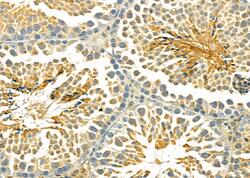
- Experimental details
- Immunohistochemistry analysis of Apelin receptor in mouse testis tissue. Samples were treated with formaldehyde and treated with citrate buffer for antigen retrieval, blocked, and incubated (1.5 hours at 22°C) with polyclonal antibody (Product # PA5-114830) at a dilution of 1:100. Secondary staining was applied with HRP conjugated anti-Rabbit.
- Submitted by
- Invitrogen Antibodies (provider)
- Main image
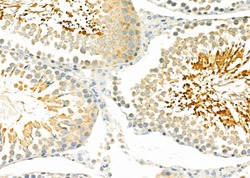
- Experimental details
- Immunohistochemistry analysis of Apelin receptor in rat testis tissue. Samples were treated with formaldehyde and treated with citrate buffer for antigen retrieval, blocked, and incubated (1.5 hours at 22°C) with polyclonal antibody (Product # PA5-114830) at a dilution of 1:100. Secondary staining was applied with HRP conjugated anti-Rabbit.
Supportive validation
- Submitted by
- Invitrogen Antibodies (provider)
- Main image
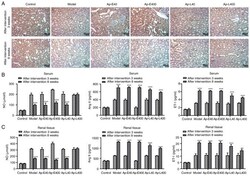
- Experimental details
- Figure 3 Apelin-13 activates the expression of APJ. (A) The expression of APJ in the kidney tissues was detected with the immunohistochemical assays (magnification, x200). (B) The production of NO was detected with the commercial kits. (C) Levels of Ang II and ET-1 were determined with commercial kits. ** P
- Submitted by
- Invitrogen Antibodies (provider)
- Main image

- Experimental details
- Figure 4 Application of apelin-13 promotes the expression of eNOS. (A) The expression of AT1R and eNOS was detected with the western blotting. (B) The levels of APJ, TGBR, E-cadherin and alpha-SMA in kidney tissues of rats were detected with western blotting. * P
- Submitted by
- Invitrogen Antibodies (provider)
- Main image
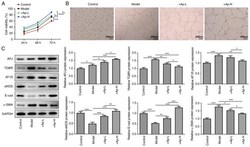
- Experimental details
- Figure 5 Apelin-13 alleviates the higher glucose-induced injury of endothelial cells of glomerular vessels. (A) Cell viability was detected with the Cell Counting Kit-8 assay. (B) hRGECs were detected with the lumen formation experiments (magnification, x4). (C) The expression of AT1R, eNOS, APJ, TGBR, E-cadherin and alpha-SMA in these cells was determined with the western blotting. * P
- Submitted by
- Invitrogen Antibodies (provider)
- Main image
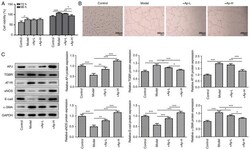
- Experimental details
- Figure 6 Apelin-13 relieves the injury of endothelial cells of glomerular vessels by suppressing fibrosis. (A) Cell viability of endothelial cells of glomerular vessels was determined with Cell Counting Kit-8 assay. (B) hRGECs were detected with the lumen formation experiments (magnification, x4). (C) The levels of AT1R, eNOS, APJ, TGBR, E-cadherin and alpha-SMA in these cells were determined with western blotting. * P
 Explore
Explore Validate
Validate Learn
Learn Western blot
Western blot